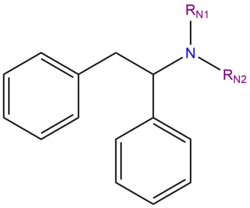This is an unofficial archive of PsychonautWiki as of 2025-08-11T15:14:44Z. Content on this page may be outdated, incomplete, or inaccurate. Please refer to the original page for the most up-to-date information.
Diarylethylamines: Difference between revisions
Jump to navigation
Jump to search
>Vlk m Embedding summary of research and reference to research into the table. Looks better to me and also more intact with original research paper. Let me know if there's a more correct way to do this type of thing. |
>BronzeManul m Implemented appropriate subscripts in 'IC50' and 'Ki'. |
||
| Line 8: | Line 8: | ||
|- | |- | ||
!Compound | !Compound | ||
! | !IC<sub>50</sub> ± SEM (nM) | ||
! | !K<sub>i</sub> ± SEM (nM) | ||
|- | |- | ||
|[[PCP]]<ref>http://gradworks.umi.com/36/90/3690548.html</ref> | |[[PCP]]<ref>http://gradworks.umi.com/36/90/3690548.html</ref> | ||
Revision as of 20:44, 1 August 2017
 |
This article is a stub. As such, it may contain incomplete or wrong information. You can help by expanding it. |

Diarylethylamines are psychoactive drugs, which typically have dissociative effects.
Pharmacology
| Compound | IC50 ± SEM (nM) | Ki ± SEM (nM) |
|---|---|---|
| PCP[2] | 91 ± 1.3 | 57.9 ± 0.8 |
| Ketamine | 508.5 ± 30.1 | 323.9 ± 19.2 |
| Memantine | 594.2 ± 41.3 | 378.4 ± 26.3 |
| (+)-MK-801 | 4.1 ± 1.6 | 2.5 ± 1.0 |
| DPH (Diphenidine) | 28.6 ± 3.5 | 18.2 ± 2.2 |
| 2-MXP (Methoxphenidine) | 56.5 ± 5.8 | 36.0 ± 3.7 |
| 3-MXP | 30.3 ± 2.6 | 19.3 ± 1.7 |
| 4-MXP | 723.8 ± 69.9 | 461.0 ± 44.5 |
| 2-Cl-DPH | 14.6 ± 2.1 | 9.3 ± 1.3 |
| NMDAR binding affinites determined using [3H]-(+)-MK-801 in rat forebrain.[3] | ||